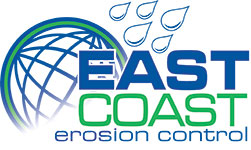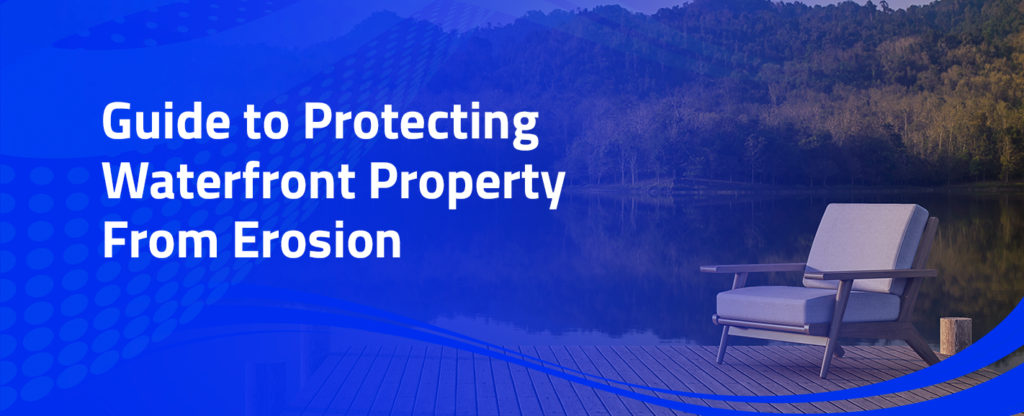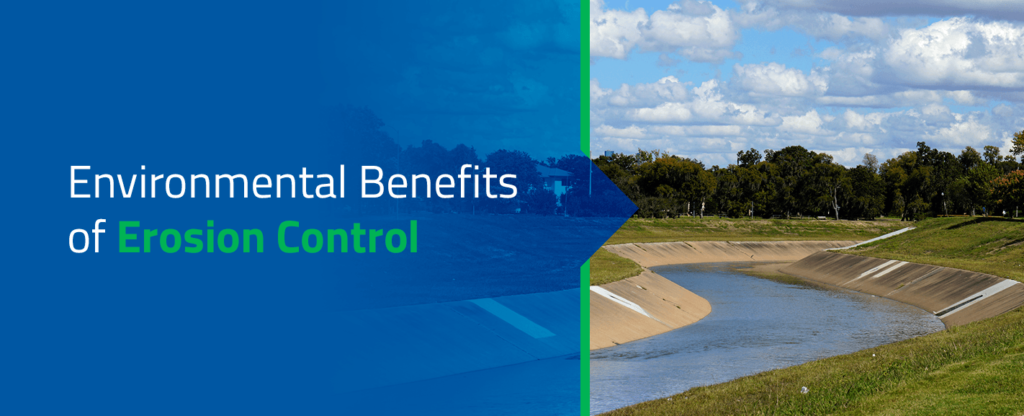Erosion Control Blanket vs. Rip Rap
SHARE
Rolled Erosion Control Products (RECPs), which include erosion control blankets and Turf Reinforcement Mats (TRMs), are constructed out of either organic or synthetic materials — sometimes both. They come packaged in rolls, which contractors can easily transport, unroll and place wherever needed. Once installed, erosion control blankets promote the growth of vegetation, which acts as a type of natural erosion control.
Rip rap — also known as rubble shot rock and rock armor — consists of strategically stacked rocks or placed cement that protect vulnerable areas from erosion by water or ice. Although they serve similar purposes, these two erosion control methods differ in a few key ways.
Rip Rap and Erosion Control Blankets: Common Applications
Engineers specify the use of either rip rap or erosion control blankets on both shorelines and coastlines, as well as steep site slopes:
Shorelines and Coastlines
Shorelines and coastlines are subject to a significant amount of erosion over time, due to a combination of water movement, flooding and runoff. Humans also tend to use these areas heavily and frequently for a variety of purposes. Rip rap and erosion control blankets help slow this erosion, while simultaneously helping to prevent any existing levees from breaching. Due to the environmental impact of coast and shoreline erosion and prevention products, many engineers request a biodegradable erosion control method, like Rolled Erosion Control Products (RECPs).
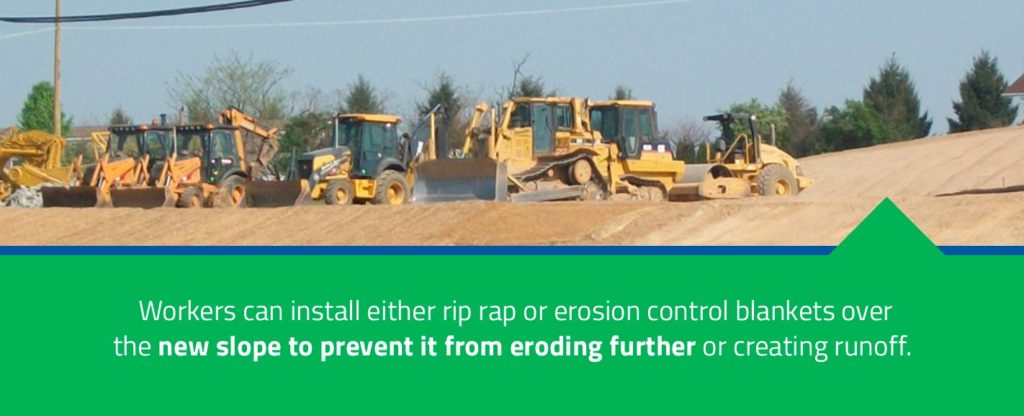
Site Slopes
Site slopes can be unavoidable, especially during and after large-scale construction projects. Newly sloped land is especially vulnerable to erosion and runoff, which can permanently alter the landscape and threaten downstream areas. Engineers can specify for installation of either rip rap or erosion control blankets over the new slope to prevent it from eroding or creating runoff.
The method of erosion control used depends on several factors, including project budget, the velocity of the anticipated water flow and whether or not the end goal is to promote the growth of vegetation.
In some instances, engineers may use rip rap and erosion blankets in tandem at the same location, such as an area where slope angles or flow rates vary at a single site.
Erosion Control Blankets vs. Stone and Concrete Rip Rap
Although rip rap and erosion control blankets sometimes have similar applications, they differ in several ways.
Erosion Control Blankets
Erosion control blankets are ideal for sites or applications that strive for Low Impact Development (LID). LID is a system of land development that focuses on protecting and preserving water quality and existing habitats. LID erosion control uses strategies to manage rainfall and minimize potentially harmful effects on the surrounding environment. One of the key principles of LID is integrating an erosion control system that can infiltrate, evaporate, store or manage runoff water close to its source. LID also calls for a control system that can help de-accelerate and maintain the rate of runoff.
There are three primary types of erosion control blankets that aid in these LID efforts:
- Permanent: Permanent erosion control blankets are long-term erosion control solutions that do not degrade over time. As an alternative to rip rap, the two most commonly used types of permanent blankets are High-Performance Turf Reinforcement Mats (HPTRMs) and Turf Reinforcement Mats (TRMs).
- Photodegradable: Photodegradable blankets are usually made of a plastic netting that intentionally stops functioning after a certain amount of time has passed. At this point, UV stabilizers in the plastic allow the blanket to degrade naturally in the sunlight.
- Biodegradable: Biodegradable erosion control blankets contain natural fibers, like coconut or straw, that break down naturally over time with little to no impact on the surrounding environment.
The Process
Erosion control blankets promote the growth of vegetation, which is the most effective form of erosion control. These RECPs hold soil — and vegetation seeds by extension — securely in place, allowing them to germinate, take root and grow.
The installation process is straightforward. Slope installation, for example, usually only requires only a few steps:
- Contractors prepare the site by grading any slopes and smoothing the soil, removing debris and filling any holes. This can be done by hand or machine, depending on the size of the project.
- Using proper soil amendment practices, seeds are then laid in the prepared area if desired.
- Contractors dig an anchor trench at the top of a slope to prevent overland flow from getting under the erosion control blanket and displacing seeds.
- Contractors place the blanket in the anchor trench and staple it to the trench bottom. They then fill the trench with compact soil.
- Next, workers roll erosion control blankets by hand across the surface and staple it into place, which holds the seeds and soil in place underneath.
Pros and Cons of Erosion Control Blankets
Erosion control blankets are a simple and effective form of erosion control. They are also safer for wildlife and can help maintain the natural processes of the environment.
When implementing an erosion control strategy, you want to have as little an impact on surrounding wildlife and ecosystems as possible. This is especially crucial if you’re working in an area that’s home to threatened or endangered species, as well as habitat-transition zones. RECPs made with natural fibers are the best way to ensure vulnerable populations and their homes are left intact because they naturally degrade over time. Natural fiber RECPs are also typically less of an obstruction for any trapped wildlife attempting to escape the netting.
Erosion control blankets also promote the growth of new vegetation, which is an essential part of maintaining the natural balance in an area. After a land clearing project, for example, the soil is often left without the same essential nutrients necessary for vegetation regrowth. Instead of leaving this land bare, erosion control blankets help seeds take root and begin the natural regrowth process.
Erosion control blankets are suitable for a variety of sites and applications, but keep in mind that incorrect selection or installation may result in failure. When working with RECPs, engineers and workers must understand which erosion control blankets are best suited for a specific project and area, as well as the correct way to install them. Otherwise, you risk the erosion control blanket moving and shifting after installation, rendering them useless.
Rip Rap
Typically, rip rap is a permanent ground cover solution. Because it consists of either large stones or concrete, the labor and expenses associated with removing or relocating these structures are costly. Rip rap is good for sites that already prohibit the growth of vegetation, like areas near culverts and bridges.
There are two primary types of rip rap:
- Concrete rip rap: Engineers utilize concrete rip rap on shorelines that require rigid protection because it resists impact damage. Construction is also simple because it doesn’t require any specialized equipment, and contractors are typically familiar with it. However, concrete rip rap is susceptible to undermining, moving and cracking, as well as erosion at the perimeters. This damage is often difficult to detect and can be challenging to repair.
- Stone protection rip rap: Stone rip rap is better suited for more flexible protection because it adapts to the shape and natural distortion of the soil. Stone rip rap is a series of interlocked stones, so workers do not need any special equipment for installation. Rip rap rocks and placement does, however, require careful design. Many engineers prefer stone rip rap over concrete because issues are more easily identified and repaired, and rock looks more natural than concrete, specifically along shorelines and coasts.
The Process
For stone rip rap, engineers design a rock formation that consists of several varied layers and sizes of rock. The material used for the stone varies and ranges from broken limestone to concrete rubble. These stones fit together in a way that allows them to absorb water impact, rather than deflect it. To prevent soil from damaging or otherwise interfering with rip rap stone, engineers first install a layer of filter material, typically consisting of either sand, gravel or fabric.
Engineers do not recommend using rip rap on slopes with a ratio greater than 2:1 — meaning the slope needs to extend two feet horizontally for every one foot of height — because the stones could shift and fall, causing further erosion and possibly endangering any people, vegetation or ecosystems located below.
Pros and Cons of Using Rip Rap
At sites where vegetation cannot already grow, engineers sometimes prefer rip rap for simplicity. Rip rap is easy to understand, use and install, and — with the exception of damaged rip rap — it does not require any difficult processes or equipment. Placed stones rip rap can also complement the landscape around the installation site. In some instances, rip rap increases the roughness and decreases the velocity of the water flow, which prompts faster settling, increasing the quality of the water.
However, rip rap is only effective if it is designed and installed correctly. Incorrectly sized or misplaced stones will shift and become displaced during heavy currents and waves, which increases site erosion and leads to costly repairs, causing more harm than good. For this reason, rip rap is not ideal for places with fast-moving water.
Rip rap is also an expensive erosion control solution due to the intense labor required to hand place and repair the stones. Once installed, rip rap requires regular inspection and maintenance. Should damage occur or water conditions change for any reason, the rip rap would require adjustment.
Rip rap also prevents natural processes from taking place at installation sites by interrupting the functions of the riparian zone, or the area between the land and water. The riparian zone is essential for the wellbeing of wildlife and the quality of the water because it reduces the energy of the water flow, filters pollutants from runoff and traps large sediment and debris to replenish shoreline soil. Rip rap stones often interfere with these important events. They are also responsible for another form of pollution in waterways: temperature pollution. Rip rap stones reflect sunlight into the water, which can raise the water temperature to an unsafe degree for the fish and other organisms living there.
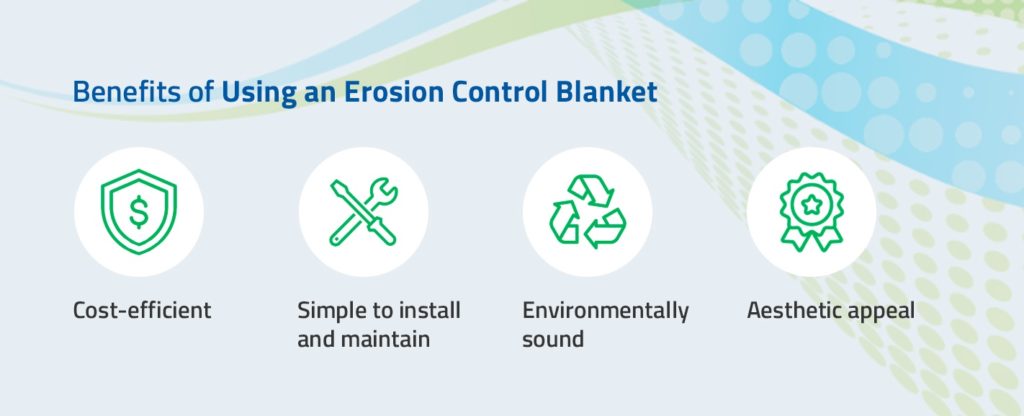
Benefits of Using an Erosion Control Blanket
Compared to rip rap, erosion control blankets have several significant benefits. For example, they are:
- Cost-efficient: Unlike rip rap, which requires extensive site planning, designing, costly materials and intense labor, erosion control blankets are a far more economical decision. The cost of East Coast Erosion TRECS HPTRM, for example, is approximately a quarter of the cost of a rip rap project of the same scope.
- Simple to install and maintain: There are only a few steps required to successfully install erosion control blankets, and installation does not require the same level of intense labor as stone and concrete rip rap. For this reason, erosion control blankets are also easier to repair, relocate or remove if necessary.
- Environmentally sound: Erosion control blankets are engineered to have a minimal environmental impact, and can actually benefit ecosystems by promoting the growth of vegetation that naturally prevents erosion and fuels ecosystems.
- Aesthetic appeal: For industries or site applications that require a less noticeable form of erosion control, blankets are better suited than stone or concrete rip rap. The netting of erosion control blankets is thin and typically blends or directly integrates into the surrounding landscape, making it difficult to detect.
Learn More About Erosion Control Blankets at East Coast Erosion Control
Stone and concrete rip rap has a place at some sites. However, when budget, maintenance and LID are crucial, RECPs are a better choice. East Coast Erosion Control has several types of erosion control blankets, depending on your project goals and desired functional longevity time.
To learn more about our products and the benefits of using erosion control blankets vs. alternative erosion control methods, view our erosion control blankets.

Further Reading
Guide to Protecting Waterfront Property From Erosion
When shoreline erosion occurs, significant problems arise for the environment and surrounding waterfront properties. Your…
Environmental Benefits of Erosion Control
In many applications like construction, vegetation removal leaves the landscape vulnerable to erosion, which washes…
Essential Today: Erosion Control Blanket Manufacturing
Why Are We Essential Erosion control products are designed to protect drinking water nationwide. Water…
